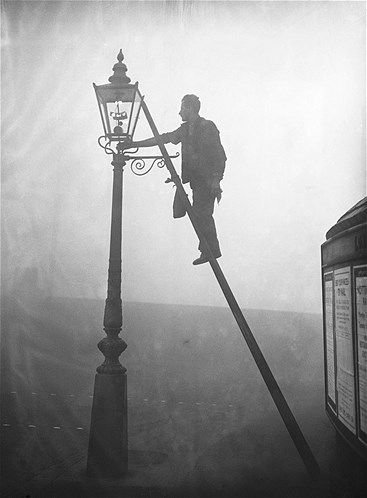The material in this article was first published in Southborough Spotlight in an article written in March 1973 by that fine local historian, Doug Bennett. It was prompted then by a dispute in the gas industry. Now, in 2022, energy supplies and rising prices are in the news once more. We are reprinting an abridged version of the original article.
A lamplighter.
Southborough had its own gas works by 1858, sited at the end of Speldhurst Road and clearly marked on the OS map of that year. Gas was expensive in those days and was only used for domestic lighting for those who could afford it.
Site of the former gasworks on Speldhurst Road.
In 1871, a proposal was made in a Council meeting, that the Gas Company should be asked to tender for lighting Southborough’s highways. In spite of some concerns about the financial viability of the Company the tender was accepted. The Gas Company agreed to erect 38 lamps and columns, to light and extinguish these lamps and to keep them properly lit from an hour after sunset until 10.30 each night, except for the five nights nearest each new moon. Obviously, it was assumed people would be safely tucked in bed after 10.30! Additionally, the lamps would not be lit between May 15th and August 15th. The annual cost of each lamp was £2. 14. 0.
The “opening ceremony” on August 16th 1871, in celebration of the coming of the lights, featured a torchlight procession and was attended by an estimated crowd of 4,000. No doubt it was an exciting public spectacle.
Rare, undated photograph of the gasworks, circa late 19th century.
Rare, undated photograph of the gasworks, circa late 19th century.
It seems as if the gas street lights weren’t an unqualified success. By 1877, the Council Lighting Committee was experimenting with paraffin oil lamps, which it was thought might prove superior to the gas lamps. Six were ordered for use near St. Peter’s Church. The number of street lights in the town increased gradually, two more being added in 1878. In 1880 Vulcan (Vale), Meadow, Bedford and Forge Roads were all illuminated. Six more lights were added elsewhere in 1883. By 1890 lamplighters were paid 8/6d per week for their services in lighting and then quenching the street lamps.
Rare, undated photograph of the gasworks, circa late 19th century.
Electric lighting was close on the horizon and two companies providing that service endeavoured to impress the Lighting Committee, with no initial success. High Brooms continued to depend on oil lamps for several more years, as the Southborough Gas Works could not provide supplies. Eventually, High Brooms had to turn to the Tunbridge Wells Gas Company for their gas lights.
In the 1890s, gas heating and cooking appliances were sold by the Council and evening classes were held, in order to show how to cook by gas. Range cookery was so very different that there would be a good deal to learn. By 1897 it became necessary to buy gas in bulk from Tunbridge Wells until 1921, when the Southborough Gas Company ceased to exist, having been bought outright by the Tunbridge Wells Company.
If anyone is able to tell us when the gasworks was demolished or any other related information or photographs, please do get in touch thesouthboroughsociety@gmail.com




















